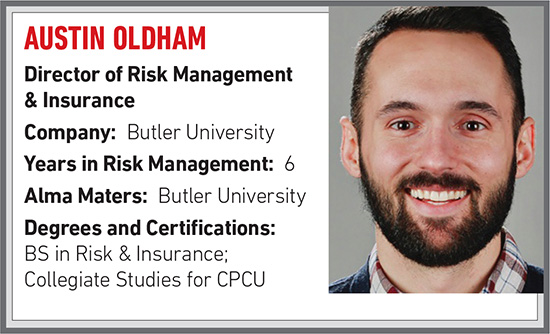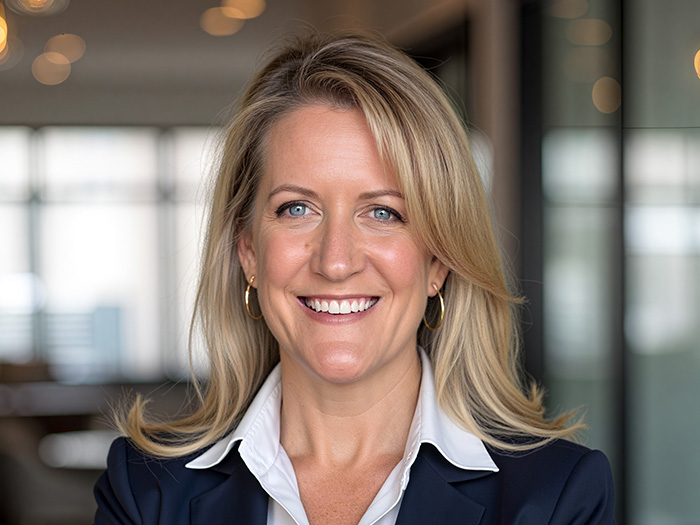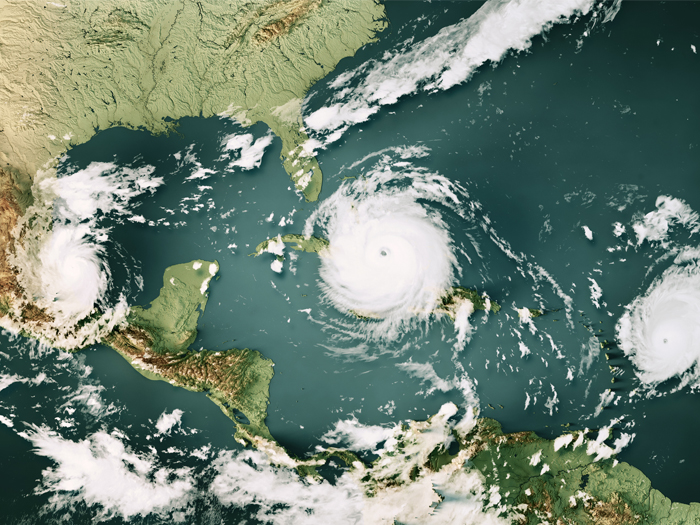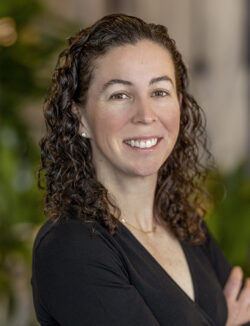This University Risk Manager Shares What’s on the Horizon for Higher Education Post-COVID-19

R&I: What was your first job?
As part of Butler’s college of business, you must have two internships before you graduate. I was able to intern with an excess and surplus managing general agent called Burns & Wilcox in Indianapolis. It was a good introduction to being an underwriter.
I did that for about six months, and then my first job after graduating was as a risk analyst at Purdue University. That’s really what introduced me to higher education. I just had the best boss there, Mark Kerbert. He’s still the director of risk management at Purdue. And he gave me a ton of responsibility, a lot of support and autonomy, so I was able to learn every function of a risk management department during my four years there.
R&I: How did you come to work in risk management?
There are probably a little more than 60 undergraduate risk management programs now, but when I was in college there were maybe around 40. So, I was very fortunate Butler picked up risk management as a degree program my sophomore year, and I was introduced to it my junior year. I just took a general elective, because I was a finance and econ major at the time.
Zach Finn was my professor, and he just sold me. He was so passionate about risk management as a career, as an industry. I just kind of fell in love with it, and it opened a lot of doors for me. I’m thankful to him and my university for offering that.
R&I: What’s been the biggest change in risk management and the insurance industry since you’ve been in it?
I’ve been in risk management now for six years and even in those six years a lot has changed. I would say more broadly, in my experience, it’s becoming crucial to have a strategic partner as your broker, coming from the perspective of an insurance buyer as a risk manager. I think, in the past, risk management was very transactional in the brokerage relationships and that won’t cut it anymore. There’s a need for a strategic partner that’s willing to look at your entire program, to look at your profiles of risk and then come up with strategies outside of traditional insurance buying that are going to get you where you want to be.
More specifically, in my experience, I think that ERM is becoming more and more ubiquitous. Risk managers are being given a seat at the table with executive leadership. They’re needed to help inform and form the decision-making process. This means that risk management and risk managers are going to need to back up the information they’re bringing to these meetings with qualitative and quantitative analysis.
The last thing is, looking at COVID-19 and specifically in higher education, the velocity of risk, and change has been increasing so much over the last six years, especially in higher ed. The things we thought were maybe five years off have been brought to our doorstep through COVID-19.
R&I: What’s the biggest challenge you’ve faced in your career?
Now, it’s kind of like before coronavirus and after. Before the pandemic, it was just taking on the current role that I’m in. I essentially was tasked with building an entire risk management and insurance program from the ground up at Butler University. So, we have a thousand employees, over 5,000 students, with over $200,000,000 in revenue and our exposures are kind of like managing a small city.
I had a little over four years of experience when I came here, and the first six to nine months were really like drinking water from a fire hose.
Now, I’ve been here for about two years, and I feel more and more comfortable and integrated into the university. It’s good to be able to look back and see the value that I’ve been able to add.
R&I: Has the COVID-19 pandemic impacted the way risk is being approached in the higher education sector?
I would say within the last few years in higher ed, there’s been a lot of talk about all the changes that are on the horizon. If you go into a classroom today on a college campus, it’s not going to be all that much of a different experience than it was 2 years ago or even 20 years ago, and I would say it’s one of few industries where that is the case.
So COVID-19 really sped up a lot of things that were on the horizon for us. We had to move to completely virtual operations as an institution in several weeks.
We had really relied on that in-person experience in the past, whereas some schools have already been working on more of a hybrid model. For us, it really forced us into virtual instruction and looking at some sort of hybrid model in the fall.
That’s just one example, but it really forced us to react and pivot in a much quicker fashion. I think that ultimately it will be a good thing as we’re looking back on this. But we’re still really in the midst of the crisis and amid planning for several contingencies in the fall. It’s really making us embrace those changes that were coming our way.
R&I: Who has been your mentor(s) and why?
The biggest one is Zach Finn. He’s the head of the Davey Risk Management program at Butler University. Now Butler has a master’s program as well, a master’s in risk & insurance, and he helped lead that along with Victor Puleo.
Zach’s the one who sold me on risk management. He showed me all the different career paths and opportunities. Ultimately, he led me to want to be on the risk management and insurance buying side. He helped open the door both at Purdue University and then for my role here at Butler. And that was cool, because now I get to work with him and collaborate with him.
At our university, we have a student-run captive insurance company that he manages on the academic side, and so we still get to work together a fair amount today. That’s special to me, and I’m glad that I get to continue to learn from him.
R&I: What is the risk management community doing right?
I think there are so many ways to get information, whether that’s conferences or student organizations and memberships. For me, that’s RIMS, being active in the local chapters as well as the annual conferences. And then there’s URMIA, the University Risk Management and Insurance Association. There are great publications. There are so many webinars.
There is a lot of content, and I would say the risk management community is very collegial and willing to share information and support one another. And again, I don’t know other industries, but I would be surprised if in other industries they are as open and willing to share and help as we are in risk management.
R&I: What could the risk management community be doing a better job of?
Technology. I think we’re heading in the right direction and we’ve made some more strides over the last two years, but I think that there’s still a gap. If you’re a really large entity, or a large account, then you have access to technological solutions that are really going to be able to help you, but what about the very small entities and the very small accounts?
They’re kind of still stuck in that transactional risk management mindset due to, in part, a lack of technology and resources in quantitative analysis that are needed. There aren’t great products out there that aren’t great products out there that are accessible for small entities.
So, at Butler, we’re kind of in the middle there. We’re not a massive school, but we’re also not very small. Even now, I’m looking at how I can leverage technology and solutions for us, and it took a lot of resources to figure out what’s the best fit for us.
R&I: How would you say technology has impacted the risk management profession?
It’s crucial. I’m a one-person department, which is more common in risk management, but still managing claims, managing a robust ERM framework, the full renewal cycle as well as being an internal consultant for risk management matters, managing business continuity day to day, it would be impossible without technology, without having some sort of software or service.
R&I: What’s your favorite book or movie?
Honestly, my favorite book is The Bible, so that’s an easy one.
R&I: What is your favorite drink?
I love coffee, all types of coffee or espresso-based drinks. I probably have six or seven different ways to make coffee at my house.
R&I: What have you accomplished that you are proudest of?
You know, I get to speak with students a lot, and I say I love what I do, but it’s not what I’m most passionate about in life. So, what I’m most passionate about is my family and my church leadership training. So, I’m most proud of just being a husband and then a father. I have a two-year-old daughter.
And the last few years I’ve gotten to travel the world and train different churches and leaders. Last year, I got to go to Cuba twice, and those were awesome experiences. The friendships that I’ve made are some of the things I’m most proud of.
R&I: What is the riskiest activity you’ve ever engaged in?
I’m not super risk averse for being a risk manager. The most recent, maybe, was about two falls ago. I was at a conference in Salt Lake City, and my broker and I went four-wheeling in the mountains of Utah, and the place did not have trails. They just give you a map and they draw on the map and tell you where you should go and where you shouldn’t go. And I’m a city boy who uses GPS in my own town still, so I’m pretty sure we got lost down there, and it was scary at times just being on a four-wheeler in the mountains in the middle of nowhere
R&I: What was your first job?
As part of Butler’s college of business, you must have two internships before you graduate. I was able to intern with an excess and surplus managing general agent called Burns & Wilcox in Indianapolis. It was a good introduction to being an underwriter.
I did that for about six months, and then my first job after graduating was as a risk analyst at Purdue University. That’s really what introduced me to higher education. I just had the best boss there, Mark Kerbert. He’s still the director of risk management at Purdue. And he gave me a ton of responsibility, a lot of support and autonomy, so I was able to learn every function of a risk management department during my four years there.
R&I: How did you come to work in risk management?
There are probably a little more than 60 undergraduate risk management programs now, but when I was in college there were maybe around 40. So, I was very fortunate Butler picked up risk management as a degree program my sophomore year, and I was introduced to it my junior year. I just took a general elective, because I was a finance and econ major at the time.
Zach Finn was my professor, and he just sold me. He was so passionate about risk management as a career, as an industry. I just kind of fell in love with it, and it opened a lot of doors for me. I’m thankful to him and my university for offering that.
R&I: What’s been the biggest change in risk management and the insurance industry since you’ve been in it?
I’ve been in risk management now for six years and even in those six years a lot has changed. I would say more broadly, in my experience, it’s becoming crucial to have a strategic partner as your broker, coming from the perspective of an insurance buyer as a risk manager. I think, in the past, risk management was very transactional in the brokerage relationships and that won’t cut it anymore. There’s a need for a strategic partner that’s willing to look at your entire program, to look at your profiles of risk and then come up with strategies outside of traditional insurance buying that are going to get you where you want to be.
More specifically, in my experience, I think that ERM is becoming more and more ubiquitous. Risk managers are being given a seat at the table with executive leadership. They’re needed to help inform and form the decision-making process. This means that risk management and risk managers are going to need to back up the information they’re bringing to these meetings with qualitative and quantitative analysis.
The last thing is, looking at COVID-19 and specifically in higher education, the velocity of risk, and change has been increasing so much over the last six years, especially in higher ed. The things we thought were maybe five years off have been brought to our doorstep through COVID-19.
R&I: What’s the biggest challenge you’ve faced in your career?
Now, it’s kind of like before coronavirus and after. Before the pandemic, it was just taking on the current role that I’m in. I essentially was tasked with building an entire risk management and insurance program from the ground up at Butler University. So, we have a thousand employees, over 5,000 students, with over $200,000,000 in revenue and our exposures are kind of like managing a small city.
I had a little over four years of experience when I came here, and the first six to nine months were really like drinking water from a fire hose.
Now, I’ve been here for about two years, and I feel more and more comfortable and integrated into the university. It’s good to be able to look back and see the value that I’ve been able to add.
R&I: Has the COVID-19 pandemic impacted the way risk is being approached in the higher education sector?
I would say within the last few years in higher ed, there’s been a lot of talk about all the changes that are on the horizon. If you go into a classroom today on a college campus, it’s not going to be all that much of a different experience than it was 2 years ago or even 20 years ago, and I would say it’s one of few industries where that is the case.
So COVID-19 really sped up a lot of things that were on the horizon for us. We had to move to completely virtual operations as an institution in several weeks.
We had really relied on that in-person experience in the past, whereas some schools have already been working on more of a hybrid model. For us, it really forced us into virtual instruction and looking at some sort of hybrid model in the fall.
That’s just one example, but it really forced us to react and pivot in a much quicker fashion. I think that ultimately it will be a good thing as we’re looking back on this. But we’re still really in the midst of the crisis and amid planning for several contingencies in the fall. It’s really making us embrace those changes that were coming our way.
R&I: Who has been your mentor(s) and why?
The biggest one is Zach Finn. He’s the head of the Davey Risk Management program at Butler University. Now Butler has a master’s program as well, a master’s in risk & insurance, and he helped lead that along with Victor Puleo.
Zach’s the one who sold me on risk management. He showed me all the different career paths and opportunities. Ultimately, he led me to want to be on the risk management and insurance buying side. He helped open the door both at Purdue University and then for my role here at Butler. And that was cool, because now I get to work with him and collaborate with him.
At our university, we have a student-run captive insurance company that he manages on the academic side, and so we still get to work together a fair amount today. That’s special to me, and I’m glad that I get to continue to learn from him.
R&I: What is the risk management community doing right?
I think there are so many ways to get information, whether that’s conferences or student organizations and memberships. For me, that’s RIMS, being active in the local chapters as well as the annual conferences. And then there’s URMIA, the University Risk Management and Insurance Association. There are great publications. There are so many webinars.
There is a lot of content, and I would say the risk management community is very collegial and willing to share information and support one another. And again, I don’t know other industries, but I would be surprised if in other industries they are as open and willing to share and help as we are in risk management.
R&I: What could the risk management community be doing a better job of?
Technology. I think we’re heading in the right direction and we’ve made some more strides over the last two years, but I think that there’s still a gap. If you’re a really large entity, or a large account, then you have access to technological solutions that are really going to be able to help you, but what about the very small entities and the very small accounts?
They’re kind of still stuck in that transactional risk management mindset due to, in part, a lack of technology and resources in quantitative analysis that are needed. There aren’t great products out there that aren’t great products out there that are accessible for small entities.
So, at Butler, we’re kind of in the middle there. We’re not a massive school, but we’re also not very small. Even now, I’m looking at how I can leverage technology and solutions for us, and it took a lot of resources to figure out what’s the best fit for us.
R&I: How would you say technology has impacted the risk management profession?
It’s crucial. I’m a one-person department, which is more common in risk management, but still managing claims, managing a robust ERM framework, the full renewal cycle as well as being an internal consultant for risk management matters, managing business continuity day to day, it would be impossible without technology, without having some sort of software or service.
R&I: What’s your favorite book or movie?
Honestly, my favorite book is The Bible, so that’s an easy one.
R&I: What is your favorite drink?
I love coffee, all types of coffee or espresso-based drinks. I probably have six or seven different ways to make coffee at my house.
R&I: What have you accomplished that you are proudest of?
You know, I get to speak with students a lot, and I say I love what I do, but it’s not what I’m most passionate about in life. So, what I’m most passionate about is my family and my church leadership training. So, I’m most proud of just being a husband and then a father. I have a two-year-old daughter.
And the last few years I’ve gotten to travel the world and train different churches and leaders. Last year, I got to go to Cuba twice, and those were awesome experiences. The friendships that I’ve made are some of the things I’m most proud of.
R&I: What is the riskiest activity you’ve ever engaged in?
I’m not super risk averse for being a risk manager. The most recent, maybe, was about two falls ago. I was at a conference in Salt Lake City, and my broker and I went four-wheeling in the mountains of Utah, and the place did not have trails. They just give you a map and they draw on the map and tell you where you should go and where you shouldn’t go. And I’m a city boy who uses GPS in my own town still, so I’m pretty sure we got lost down there, and it was scary at times just being on a four-wheeler in the mountains in the middle of nowhere. &











